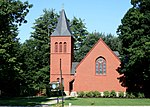Lower Intervale Grange No. 321

The Lower Intervale Grange #321, at 471 Daniel Webster Highway in the town of Plymouth in Grafton County, New Hampshire, was listed on the National Register of Historic Places in 2022.The Grange Hall was built in 1912, and the building has changed little since.It was listed "for its architectural integrity as well as for its association with the national Grange movement."It is a one-and-a-half-story building, clapboarded, with a "distinctive shed roof" and a front-facing gable. Its front porch, rebuilt in 2021, includes original or restored balusters, "corner posts with ornamental turnings and scrolled sawn brackets." Two cornerstones show "1912" and "L.I.G." Apparently ten cents was the price to have your name recorded in paper within one of the cornerstones. Its lower level is accessible from the side and includes kitchen facilities.The Manchester Ink Link online newspaper has published photos of the main meeting space and of the exterior.
Excerpt from the Wikipedia article Lower Intervale Grange No. 321 (License: CC BY-SA 3.0, Authors, Images).Lower Intervale Grange No. 321
Daniel Webster Highway,
Geographical coordinates (GPS) Address Nearby Places Show on map
Geographical coordinates (GPS)
| Latitude | Longitude |
|---|---|
| N 43.7237 ° | E -71.6761 ° |
Address
Daniel Webster Highway 425
03264
New Hampshire, United States
Open on Google Maps








